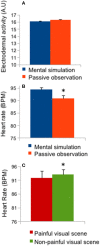Mental Simulation of Painful Situations Has an Impact on Posture and Psychophysiological Parameters
- PMID: 29209250
- PMCID: PMC5702461
- DOI: 10.3389/fpsyg.2017.02012
Mental Simulation of Painful Situations Has an Impact on Posture and Psychophysiological Parameters
Abstract
Embodiment is made possible by the ability to imagine ourselves in a particular situation (mental simulation). Postural changes have been demonstrated in response to painful situations, but the effect of an implicit instruction has not been studied. The present study was designed to record differential responses according to whether or not subjects were instructed to imagine themselves in a painful or non-painful situation. Painful stimuli and instructions to mentally simulate the displayed situation were hypothesized to induce postural changes that could be demonstrated by changes in the center of pressure (COP) trajectory compared to viewing the same stimuli with no instructions. We hypothesized that mental simulation of a painful situation would induce embodiment of the emotional situation as reflected by posterior displacement of the COP and physiological responses as compared to passive observation of the same visual scene. Thirty-one subjects participated in this study while standing quietly on a posturographic platform with presentation of visual stimuli depicting scenes defining three experimental conditions (painful, non-painful and neutral situations) for 12 s. Physiological measurements [heart rate (HR) and electrodermal activity] and postural responses (COP displacements) were recorded in response to the stimuli with or without instructions to imagine themselves in the situation. Time-course analyses (1 s sliding window) were conducted for several postural parameters, HR and electrodermal response. An interaction effect (instruction × stimuli × time) demonstrated that mental simulation induced posterior displacement of the mean position of the COP at different times during presentation of visual stimuli (4 s; 9-12 s). An effect of instruction was reported for HR (HR was higher in the mental simulation condition), while a stimulation effect was reported only for HR (lower for painful stimuli than for non-painful stimuli). The results of time-course analyses demonstrated embodiment of painful situations by postural control modulations and physiological changes depending on whether or not the participants were instructed to imagine themselves in the situation.
Keywords: embodiment; embodiment theory; empathy for pain; motor correlates; posturography.
Figures




Similar articles
-
Non-Linear Measures of Postural Control in Response to Painful and Non-Painful Visual Stimuli.Entropy (Basel). 2023 Nov 19;25(11):1561. doi: 10.3390/e25111561. Entropy (Basel). 2023. PMID: 37998253 Free PMC article.
-
Postural correlates of painful stimuli exposure: impact of mental simulation processes and pain-level of the stimuli.Exp Brain Res. 2021 Jun;239(6):1929-1936. doi: 10.1007/s00221-021-06102-y. Epub 2021 Apr 19. Exp Brain Res. 2021. PMID: 33876262
-
Postural correlates with painful situations.Front Hum Neurosci. 2013 Feb 5;7:4. doi: 10.3389/fnhum.2013.00004. eCollection 2013. Front Hum Neurosci. 2013. PMID: 23386816 Free PMC article.
-
Postural Correlates of Pollution Perception.Brain Sci. 2022 Jun 30;12(7):869. doi: 10.3390/brainsci12070869. Brain Sci. 2022. PMID: 35884676 Free PMC article.
-
Importance of Temporal Analyzes for the Exploration of the Posturographic Correlates of Emotional Processing.Front Behav Neurosci. 2018 Nov 15;12:277. doi: 10.3389/fnbeh.2018.00277. eCollection 2018. Front Behav Neurosci. 2018. PMID: 30498436 Free PMC article. Review.
Cited by
-
Posturography Approaches: An Insightful Window to Explore the Role of the Brain in Socio-Affective Processes.Brain Sci. 2023 Nov 12;13(11):1585. doi: 10.3390/brainsci13111585. Brain Sci. 2023. PMID: 38002545 Free PMC article.
-
Empathy bodyssence: temporal dynamics of sensorimotor and physiological responses and the subjective experience in synchrony with the other's suffering.Front Psychol. 2024 Mar 21;15:1362064. doi: 10.3389/fpsyg.2024.1362064. eCollection 2024. Front Psychol. 2024. PMID: 38577111 Free PMC article.
-
Moving beyond the lab: investigating empathy through the Empirical 5E approach.Front Psychol. 2023 Jul 13;14:1119469. doi: 10.3389/fpsyg.2023.1119469. eCollection 2023. Front Psychol. 2023. PMID: 37519389 Free PMC article.
-
Non-Linear Measures of Postural Control in Response to Painful and Non-Painful Visual Stimuli.Entropy (Basel). 2023 Nov 19;25(11):1561. doi: 10.3390/e25111561. Entropy (Basel). 2023. PMID: 37998253 Free PMC article.
-
Postural correlates of painful stimuli exposure: impact of mental simulation processes and pain-level of the stimuli.Exp Brain Res. 2021 Jun;239(6):1929-1936. doi: 10.1007/s00221-021-06102-y. Epub 2021 Apr 19. Exp Brain Res. 2021. PMID: 33876262
References
LinkOut - more resources
Full Text Sources
Other Literature Sources

